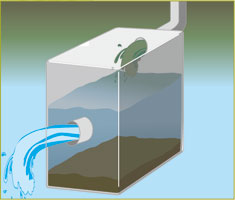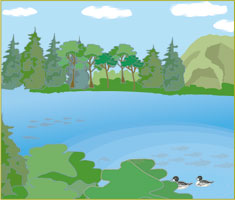Environmental Improvement in Lakes and Seas: Lakes and Reservoirs
 @
@ @
@
@Verification is implemented for technologies that can remove pollutants (organic matters and nutrient salts) and algae, enhance the degree of clearness, reduce the elution of pollutants from sludge, etc., and are directly applicable in the field.
Background of Water Purification Technologies for Lakes and Reservoirs
- Since lakes are closed water areas, they have specific conditions such as difficulty in purification when pollutants were accumulated in them. Therefore, their achievement rate of the environment standard on COD (chemical oxygen demand), an index of organic pollution, has been about 50, which is lower compared with other water areas. Degradation of lake water quality is caused by inflow and accumulation of nutrient salts (nitrogen, phosphorus) and organic pollutants from a river basin. Abnormal odor / taste problems of tap water, spoiling of scenery, etc., caused by abnormal proliferation of phytoplankton have occurred in various parts of the country.
- In addition to the conventional wastewater regulations concerning organic matters, etc., wastewater regulations have been strengthened as a measure to conserve lake water quality since 1985 based on the Water Quality Pollution Control Act, designating the lakes targeted by the wastewater regulations concerning nitrogen and phosphorus contents that cause eutrophication. However, lake water quality has not been sufficiently improved yet. In parallel with the reduction of pollution loads flowing into lakes by developing wastewater treatment technologies, many technologies to directly purify lake water itself have been proposed recently.
- Therefore, we consider the following activities are significant, that is, activities to conserve local environments, and to develop and promote technologies that directly purify lake water itself by implementing verification tests for lake water purification technologies and by providing objective information concerning the environment conservation effect (this means purification of lake water quality in the case of this technical field) of the target technologies. Thus, we select this as a target technology field and are implementing its verification project.